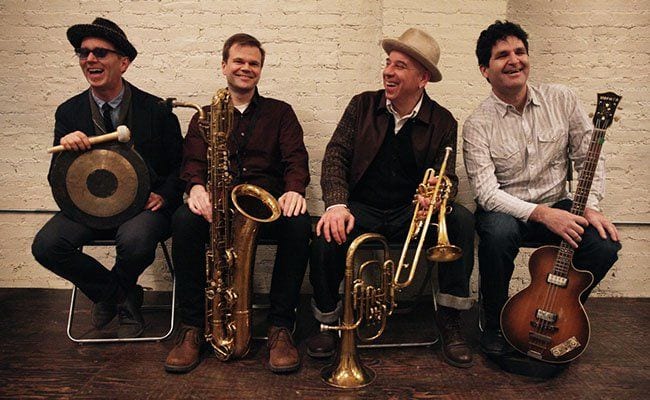
Sexmob is the band that features Steven Bernstein playing the slide trumpet. The “slide trumpet”?, you say, and then you get Googling it on your phone, only to learn that this elusive instrument is medieval in origin, evolving into the “sackbut”, which then became the slide trombone. There were later slide trumpets with the same idea at their core: a brighter, higher trumpet-range horn that uses a slide rather than valves to change pitches. (Maynard Ferguson had a “Firebird” trumpet created — with both valves and a slide — but that is not the object of Sexmob’s desire.) The bottom line: the slide trumpet is one crazy, rare, wondrous thing. And the guy who is the master of it in 2017: also crazy, rare and wondrous.
Beyond the leader/composer/antic showman Steve Bernstein, Sexmob features saxophonist Briggan Krauss, bassist Tony Scherr, and drummer Kenny Wollesen. The band, around since 1997 when it was gigging at the old Knitting Factory in downtown NYC, is crazy, rare, and wondrous as a whole: a jazz band with a sense of wit and play. It shares some DNA with Lester Bowie and his bands (including Brass Fantasy and the Art Ensemble of Chicago), but Sexmob also comes from Bernstein’s experiences playing in improvisational groups that skirted the “jazz” label at placed like Danceteria back in the late 1980s.
So, the first tune on Cultural Capital begins with Wollesen rapping out a funky-as-shit eighth note groove with a hard snap on the three, paired with a dirty acoustic bass line. The melody (alto sax and trumpet) is in ominous unison, then it breaks into harmony and snaps back again. Eventually, overdubbed guitars come in for a scratchy climax. This will not be a program of standard jazz — or even standard “out” jazz.
Sexmob has usually played tunes from unusual sources. Bernstein favors strong melodies from Fellini films, ABBA, stuff by Prince and Nirvana and the Grateful Dead. Sexmob once tackled a whole album of James Bond songs. Sexmob has typically come at you with something you knew, then used that familiar melody to channel its distinctive freedom and vision. You like “Live and Let Die”? Well, try not to love the wildly expressive version by Sexmob which is both loose and crazy, ragged around the edges, and also funky as all get out, with slamming drums, skronky guitar, and also a sloppy joy that reminds you of a second line groove from New Orleans.
Cultural Capital, a rare set of strictly original platforms composed by Bernstein. It features overdubs and guitars from Krauss and Scherr, which means layers of interest and arrangement. Take “Valentino”, a mid-tempo workout over a slightly exotic rhythm — with its interlocking guitar melodies, its pulsing trumpet harmonies, and its throbbing bass drum groove. All told, it adds up to a small big band. Or how about “Golden House”, with its New Orleans street rhythms and inviting overdubs that generate a feeling of a good-sized brass band, bobbing and weaving its way through a funeral.
The program is tremendously varied, and not every tune seems designed for whimsy. “Helmland” is a mournful, slow elegy that pairs trumpet with baritone saxophone, and the gravity of the tune is found in its gospel harmonic structure. Wollesen gets to solo almost continuously as the other guys move you down a church aisle.
The performances on Cultural Capital are mostly short, and they work as a kind of dim sum meal. Little tastes are enough. “4 Cents” is a grooving pattern set up by bass and toms over which the horns build a throbbing crescendo. But that’s it, no real solos, just one cool idea, set forth for you to dig. “Lacey” is a minute-long slice of cool swing that houses quiet licks behind a Krauss solo, then a hip head arrangement that’s over before you know it. “Giant Minds” is gentle, long-form melody that unspools as a series of three-note figures (short, short, looooong), then a subtle variation that merges the first two notes. It’s an act of three-minute hypnotism.
What the recording sacrifices, then, are larger doses of improvisation. “Hear You”, for example, is among the longer tracks but features only scripted horn parts and a short drum solo. But that’s the design of Cultural Capital, and the rewards are considerable. That same tune blends directly into the hip “SF”, which starts with rave-up 12/8 grooving then eases down to a quiet, minimalist soul feeling. No big Coltrane-ish statements? That’s okay when the ideas are this tasty and the textures this varied. Bernstein and Krauss tend to play their solo statements like they were parts of the composition anyway… and isn’t that the way it ought to be?
Maybe the better metaphor for Cultural Capital is a mosaic, a quilt. The album is a collection of beautiful patches, flashes of texture, rhythm, pulse, melody, but it looks best and most interesting as a whole. Playing it several times, all the way through, it came together as something more interesting and whole that any one tune could claim. The contrasts are part of it, the singularity of that slide trumpet, the willingness of the band to go any direction… but in the end, the stitches hold.


![Call for Papers: All Things Reconsidered [MUSIC] May-August 2024](https://www.popmatters.com/wp-content/uploads/2024/04/all-things-reconsidered-call-music-may-2024-720x380.jpg)



